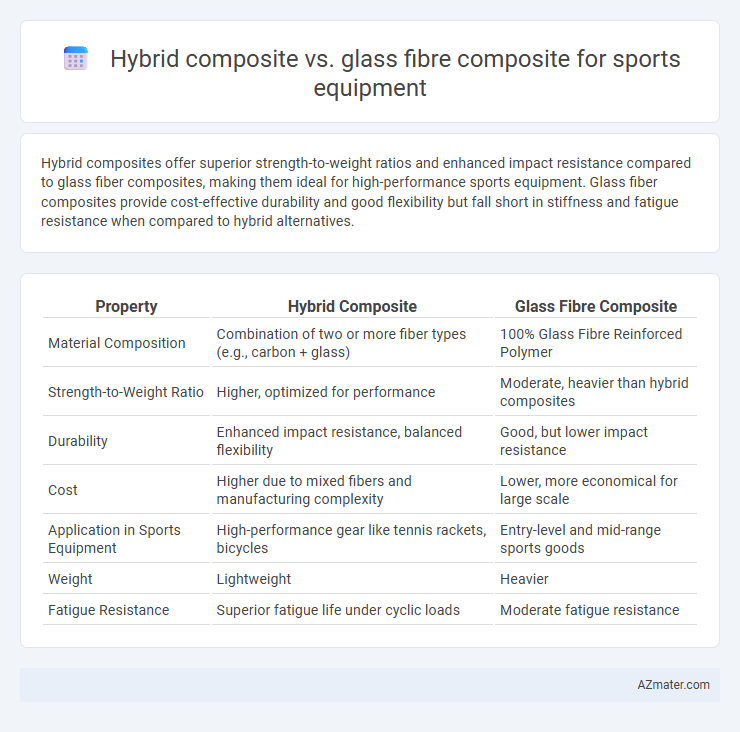Hybrid composites offer superior strength-to-weight ratios and enhanced impact resistance compared to glass fiber composites, making them ideal for high-performance sports equipment. Glass fiber composites provide cost-effective durability and good flexibility but fall short in stiffness and fatigue resistance when compared to hybrid alternatives.
Table of Comparison
| Property | Hybrid Composite | Glass Fibre Composite |
|---|---|---|
| Material Composition | Combination of two or more fiber types (e.g., carbon + glass) | 100% Glass Fibre Reinforced Polymer |
| Strength-to-Weight Ratio | Higher, optimized for performance | Moderate, heavier than hybrid composites |
| Durability | Enhanced impact resistance, balanced flexibility | Good, but lower impact resistance |
| Cost | Higher due to mixed fibers and manufacturing complexity | Lower, more economical for large scale |
| Application in Sports Equipment | High-performance gear like tennis rackets, bicycles | Entry-level and mid-range sports goods |
| Weight | Lightweight | Heavier |
| Fatigue Resistance | Superior fatigue life under cyclic loads | Moderate fatigue resistance |
Introduction to Composite Materials in Sports Equipment
Composite materials in sports equipment combine different fibers with polymer matrices to enhance strength, stiffness, and impact resistance. Hybrid composites, integrating fibers such as carbon and Kevlar alongside glass fiber, offer tailored performance by synergizing high tensile strength and flexibility. Glass fibre composites remain popular due to their affordability, durability, and favorable strength-to-weight ratio, making them ideal for applications requiring moderate performance and cost-efficiency.
Overview of Hybrid Composite Materials
Hybrid composite materials combine two or more types of fibers, such as carbon and glass fibers, to enhance mechanical properties in sports equipment, offering superior strength-to-weight ratios compared to glass fiber composites alone. These materials provide improved impact resistance and fatigue durability, making them ideal for high-performance applications like tennis rackets, bicycles, and helmets. The synergy between different fibers results in optimized stiffness, flexibility, and energy absorption tailored to specific sports demands.
Key Characteristics of Glass Fibre Composites
Glass fibre composites exhibit high tensile strength, excellent impact resistance, and good flexibility, making them ideal for sports equipment requiring durability and lightweight properties. Their inherent corrosion resistance and cost-effectiveness contribute to widespread use in manufacturing items like tennis rackets, fishing rods, and protective helmets. Unlike hybrid composites, glass fibre composites offer consistent performance under repetitive stress and environmental exposure, ensuring reliable athletic performance.
Performance Comparison: Strength and Durability
Hybrid composites in sports equipment offer superior strength and durability compared to traditional glass fibre composites by combining multiple fibre types, such as carbon and glass, to enhance mechanical properties and impact resistance. Glass fibre composites provide reasonable tensile strength and cost-efficiency but generally exhibit lower fatigue resistance and stiffness compared to hybrid alternatives. The tailored fibre orientation in hybrid composites enables optimized load distribution, resulting in improved performance under repetitive stress and longer lifespan for sports applications.
Weight and Flexibility Considerations
Hybrid composites, combining carbon fibers with glass fibers, offer superior strength-to-weight ratios and enhanced flexibility compared to pure glass fibre composites, which tend to be heavier and less adaptable under dynamic loads. The lower density of carbon fibers in hybrid composites significantly reduces overall equipment weight, crucial for high-performance sports applications requiring agility and speed. Flexibility in hybrid composites can be tailored through fiber orientation, providing optimal energy absorption and resilience, whereas glass fibre composites often lack this customizable elasticity.
Cost-Effectiveness and Manufacturing
Hybrid composites offer enhanced mechanical properties by combining different fibers, leading to better performance and potentially lower material costs compared to pure glass fiber composites in sports equipment manufacturing. The manufacturing process for hybrid composites can be more complex and may require advanced techniques, but this investment often results in lightweight, durable products that justify the initial cost. Glass fiber composites remain a cost-effective option due to their established production methods and lower material expenses, making them suitable for mass-produced sports gear where budget constraints are critical.
Impact Resistance and Safety Features
Hybrid composites offer superior impact resistance and enhanced safety features compared to traditional glass fibre composites in sports equipment. The combination of various fibers in hybrid composites absorbs and disperses impact energy more effectively, reducing the risk of fractures and injuries during high-intensity activities. This improved durability and safety make hybrid composites ideal for protective gear such as helmets, pads, and high-performance sports equipment.
Customization Potential for Sports Applications
Hybrid composites offer superior customization potential for sports equipment by allowing the combination of different fibers, such as carbon and glass, to tailor strength, flexibility, and weight characteristics to specific athletic requirements. Glass fibre composites provide reliable strength and cost-effective solutions but lack the adaptability of hybrids to fine-tune performance attributes like impact resistance and stiffness for diverse sports applications. The ability to optimize fiber orientation, layering sequences, and resin systems in hybrid composites enables manufacturers to create highly specialized gear that enhances athlete performance and ensures durability.
Sustainability and Environmental Impact
Hybrid composites in sports equipment combine natural fibers with synthetic materials, offering enhanced sustainability by reducing reliance on pure glass fibers and lowering overall carbon footprints. Glass fibre composites, while durable and strong, involve energy-intensive production processes and pose recycling challenges due to their non-biodegradable nature. The integration of bio-based resins and hybridization techniques in composites promotes eco-friendly alternatives, improving environmental impact without compromising athletic performance.
Conclusion: Choosing the Right Composite for Sports Equipment
Hybrid composites combine the strength and stiffness of carbon fibers with the flexibility and impact resistance of glass fibers, offering a balanced performance ideal for high-impact sports equipment. Glass fibre composites provide excellent durability and cost-effectiveness, making them suitable for recreational or entry-level products where budget and toughness are priorities. Selecting the right composite depends on the specific performance requirements, budget constraints, and intended use, with hybrid composites favored for advanced athletic gear demanding optimized strength-to-weight ratio and fatigue resistance.

Infographic: Hybrid composite vs Glass fibre composite for Sports equipment
 azmater.com
azmater.com